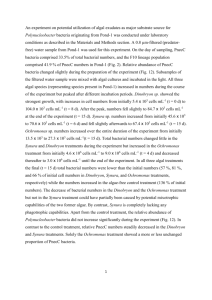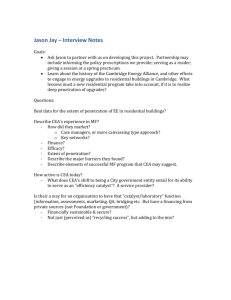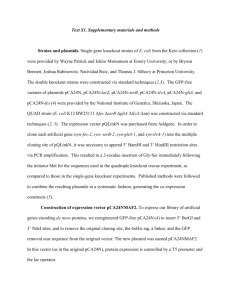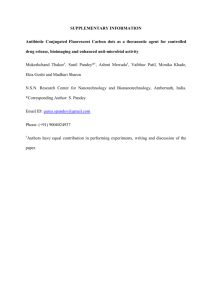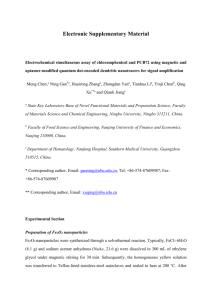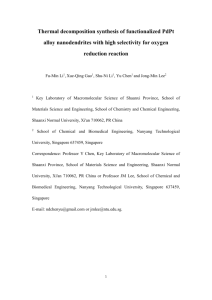Supporting Information - Springer Static Content Server
advertisement
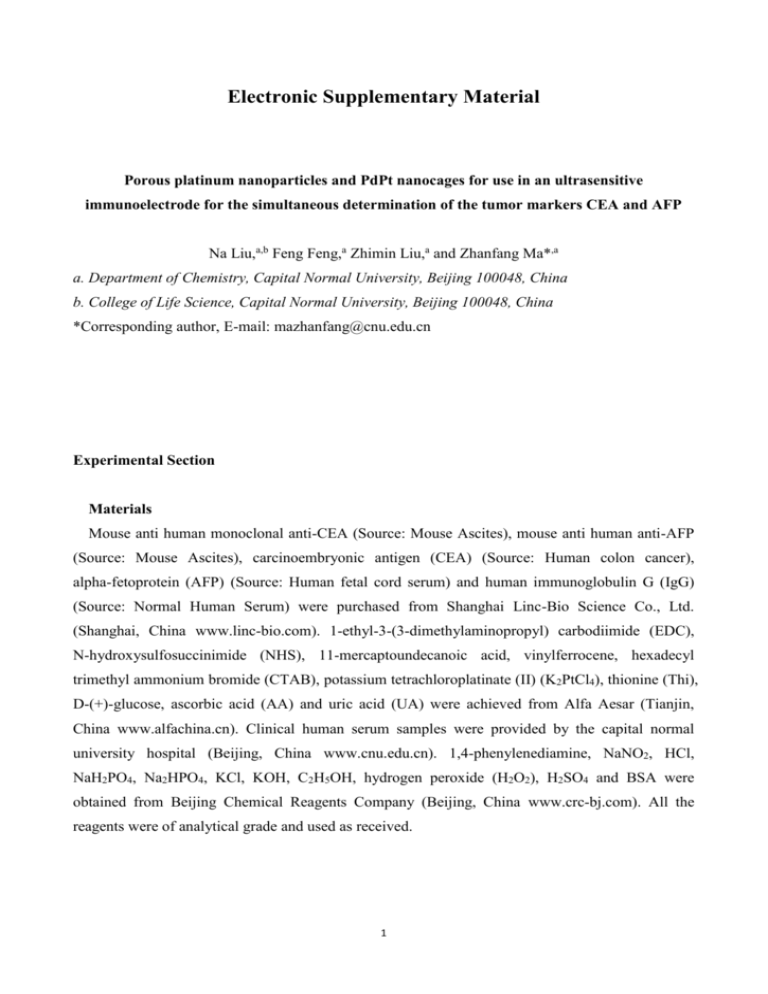
Electronic Supplementary Material Porous platinum nanoparticles and PdPt nanocages for use in an ultrasensitive immunoelectrode for the simultaneous determination of the tumor markers CEA and AFP Na Liu,a,b Feng Feng,a Zhimin Liu,a and Zhanfang Ma*,a a. Department of Chemistry, Capital Normal University, Beijing 100048, China b. College of Life Science, Capital Normal University, Beijing 100048, China *Corresponding author, E-mail: mazhanfang@cnu.edu.cn Experimental Section Materials Mouse anti human monoclonal anti-CEA (Source: Mouse Ascites), mouse anti human anti-AFP (Source: Mouse Ascites), carcinoembryonic antigen (CEA) (Source: Human colon cancer), alpha-fetoprotein (AFP) (Source: Human fetal cord serum) and human immunoglobulin G (IgG) (Source: Normal Human Serum) were purchased from Shanghai Linc-Bio Science Co., Ltd. (Shanghai, China www.linc-bio.com). 1-ethyl-3-(3-dimethylaminopropyl) carbodiimide (EDC), N-hydroxysulfosuccinimide (NHS), 11-mercaptoundecanoic acid, vinylferrocene, hexadecyl trimethyl ammonium bromide (CTAB), potassium tetrachloroplatinate (II) (K2PtCl4), thionine (Thi), D-(+)-glucose, ascorbic acid (AA) and uric acid (UA) were achieved from Alfa Aesar (Tianjin, China www.alfachina.cn). Clinical human serum samples were provided by the capital normal university hospital (Beijing, China www.cnu.edu.cn). 1,4-phenylenediamine, NaNO2, HCl, NaH2PO4, Na2HPO4, KCl, KOH, C2H5OH, hydrogen peroxide (H2O2), H2SO4 and BSA were obtained from Beijing Chemical Reagents Company (Beijing, China www.crc-bj.com). All the reagents were of analytical grade and used as received. 1 Apparatus In all the procedures, the water used was purified through an Olst ultrapure K8 apparatus (Olst, Ltd., resistivity=18.2 MΩ cm-1). Transmission electron microscopy (TEM) was performed with a JEOL-100CX electron microscope under 80 kV accelerating voltage. Scanning electron microscopy (SEM) images were obtained from a Hitachi SU8010 SEM. X-ray photoelectron spectroscopy (XPS) was conducted using an Escalab 250 X-ray Photoelectron Spectroscope (Thermofisher, American) employing a monochromatic Al Kα radiation. Electrochemical measurements were carried out on CHI-832 electrochemical workstation (Chenhua Instruments Co., Shanghai, China). High-resolution transmission electron microscope (HRTEM), high angle annular dark field scanning transmission electron microscopy (HAADF-STEM), and EDX mapping characterizations were obtained on a jeol-2011 electron microscope. Electrochemical impedance spectroscopy (EIS) was measured by Advanced Electrochemical System of PARSTAT 2273 (Princeton Co. USA). A three-electrode system was used in the experiment with a glassy carbon electrode (4 mm in diameter) as the working electrode, an Ag/AgCl electrode (saturated KCl) and a Pt wire electrode as reference electrode and counter-electrode, respectively. Supersonic cleaner was purchased from Kunshan Ultrasonic Instruments Co., Ltd. High speed centrifuge was purchased from Shanghai Anting Scientific Instrument Factory. Synthesis of PdPt nanocages (PdPt NCs) The PdPt NCs were synthesized following the previous report with a little modification. [1] In a typical synthesis, Pd nanocube with an edge length of 15 nm was prepared by adding 0.5 mL of 10 mM H2PdCl4 aqueous solution to 10 mL of 12.5 mM CTAB aqueous solution at 95 °C. After 5 min, 0.08 mL of a freshly prepared 100 mM aqueous solution of AA was added. The reaction was allowed to proceed for 10 min and was stopped by cooling to room temperature. The product was collected by centrifugation, washed several times with water to completely remove CTAB and AA. The PdPt NCs were prepared using a seed-mediated method. In a typical synthesis, 2 mL of Pd nanocube seed solution (1 mM Pd) and 1 mL of 5 mM K2PtCl4 were added to a 7 mL of 20 mM CTAB aqueous solution. The mixture was then heated to 100 °C and maintained at this temperature for 24 h with vigorous stirring. The product was collected by centrifugation, washed several times with water to remove excess CTAB, and redispersed in 10 mL of water. Preparation of immunosensing probe The immunosensing probes were prepared by immobilizing antibodies and redox probes successively onto PdPt NCs. Briefly, the PdPt NCs labeled anti-CEA and Thi (anti-CEA-PdPt-Thi) 2 was prepared as follows: 10 L of 10 mM 11-mercaptoundecanoic acid in ethanol was added to 990 L of the PdPt NCs stored in water followed by sonication for 30 min and stir a further 3 h at room temperature before centrifugation and redispersion in water. Next, 10 L of a freshly prepared EDC and NHS (7.5 mM: 1.5 mM) was then added to the mixture at room temperature and reacted for 10 min. Then the mixture was centrifuged at 12000 rpm for 10 min to remove excessive EDC and NHS, and the precipitation was dispersed in 2 mL PBS (0.01 M, pH 7.3). Subsequently, labeled anti-CEA (200 L, 1 mg mL-1) was added into the dispersion and gently mixed for 6 h. After centrifugation, the obtained bioconjugate was mixed with 2 mL of 1 mM Thi solution and stirred for 2 h at room temperature. The resulting nanocomposite was then blocked with 1 % BSA solution for 2 h to block any possible remaining active sites to avoid nonspecific absorption. After centrifuged and washed for several times, the obtained nanocomposite was redispersed in 2 mL PBS (0.01 M, pH 7.3) and the stored at 4 °C when not in use. The PdPt NCs labeled anti-AFP and NH2-Fc (anti-AFP-PdPt-Fc) was prepared by the same method. Simultaneous measurement procedure Based on the typical procedure of sandwich-type immunoreactions, the prepared immunosensor was first incubated with a sequence of standard solutions of CEA and AFP with different concentrations at 37 °C for 40 min, and then it was incubated with the mixture of 1:1 diluted anti-CEA-PdPt-Thi and anti-AFP-PdPt-Fc. After every step, the electrodes were washed with 0.01 M PBS (pH 7.3). Subsequently, SWV was performed to record the electrochemical responses for simultaneous measurement of CEA and AFP in 0.1 M pH 6.5 PBS, containing 5 mM H2O2. The square wave voltammetry (SWV) measurement was taken from -0.6 V to 1 V (vs Ag/AgCl) with a frequency of 15 Hz and a pulse amplitude of 25 mV. 3 Figure S1. HAADF-STEM image (A) and corresponding HAADF-STEM-EDS mapping images (B and C) of Pd@Pt nanocage. The green and red colors in HAADF-STEM-EDS mapping images indicate Pd and Pt, respectively. (D) HAADF-STEM image and cross-sectional compositional line profiles of Pd@Pt nanocage. Figure S2. Effect of pH of detection solution (A) and incubation time (B) on SWV responses to 2 ng mL-1 CEA and AFP at the immunosensor array. 4 Figure S3. Current response of the immunosensor to 2 ng mL-1 CEA and AFP, 2 ng mL-1 CEA and AFP+100 ng mL-1 immunoglobulin G (IgG), 2 ng mL-1 CEA and AFP+100 ng mL-1 bovine serum albumin (BSA), 2 ng mL-1 CEA and AFP+100 ng mL-1 ascorbic acid (AA), 2 ng mL-1 CEA and AFP+100 ng mL-1 glucose, 2 ng mL-1 CEA and AFP+100 ng mL-1 uric acid (UA). Table S1. Interference degree or cross-talk level. Sample type Concentration (ng mL-1) Current shift at CEA position (µA)a, b Current shift at AFP position (µA)a, c 0.3 20.69 0.07 10 51.07 0.12 0.3 0.11 20.03 10 0.14 50.86 0.3+0.3 20.73 20.08 10+10 51.13 50.93 CEA AFP CEA +AFP a The average value of three measurements in PBS, pH 6.5. b The SWV peak current was ~ 0.901 µA for zero CEA analyte. c The SWV peak current was ~ 0.694 µA for zero AFP analyte. Reference 1. Hong JW,Kang SW,Choi BS, Kim DH, Lee SB, Han SW (2012) ACS Nano 6:2410-2419 5

